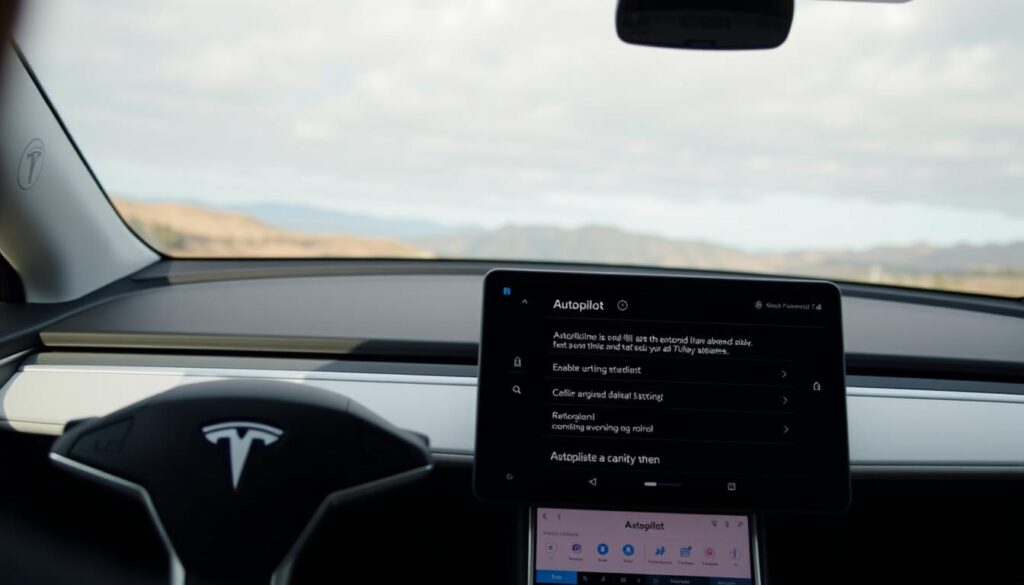The Tesla Model Y is equipped with advanced Autopilot technology, designed to enhance safety and convenience on the road. This feature is a significant aspect of Tesla’s commitment to innovation and customer experience.
By enabling Autopilot, drivers can enjoy a more relaxed driving experience, especially during long trips or heavy traffic conditions. Autopilot technology assists with steering, acceleration, and braking, making it a valuable feature for Tesla Model Y owners.
Key Takeaways
- Understand the basics of Tesla’s Autopilot technology.
- Learn how to enable Autopilot in your Tesla Model Y.
- Discover the benefits of using Autopilot during your drive.
- Explore the safety features integrated into Autopilot technology.
- Find out how Autopilot can enhance your driving experience.
Understanding Tesla Autopilot Technology
Understanding Tesla Autopilot technology is crucial for Model Y owners who want to leverage its advanced driving capabilities. Tesla’s Autopilot is a sophisticated system designed to assist with various driving tasks, enhancing both safety and convenience on the road.
What Autopilot Actually Does
Tesla Autopilot is an advanced driver-assistance system (ADAS) that enables semi-autonomous driving. It uses a combination of cameras, sensors, and radar to detect the vehicle’s surroundings, making driving safer and more efficient. For more detailed information on using Autopilot features like cruise control, visit effortless driving cruise control tips for Tesla Model.
Difference Between Autopilot and Full Self-Driving
While Autopilot is a significant feature, it’s essential to distinguish it from Full Self-Driving (FSD). Autopilot is designed for semi-autonomous driving and requires driver supervision. In contrast, Full Self-Driving is a more advanced capability aimed at achieving fully autonomous driving, although it’s still under development and testing.
Benefits of Using Autopilot in Your Model Y
The benefits of using Autopilot in your Tesla Model Y include enhanced safety features, reduced driver fatigue, and improved driving convenience. Autopilot can assist with tasks such as steering, braking, and acceleration, making long drives less strenuous.
| Feature | Autopilot | Full Self-Driving |
|---|---|---|
| Semi-Autonomous Driving | Yes | Yes |
| Fully Autonomous Driving | No | Yes (Under Development) |
| Driver Supervision Required | Yes | Eventually No |

Prerequisites Before Enabling Autopilot
Before enabling Autopilot in your Tesla Model Y, it’s crucial to ensure your vehicle meets specific prerequisites. This ensures a safe and effective Autopilot experience.
Checking Your Tesla Model Y’s Autopilot Capabilities
To verify that your Tesla Model Y is equipped with Autopilot, you need to check two key aspects: the hardware version and your Autopilot subscription status.
Identifying Hardware Version
Navigating to the ‘Software’ section in your Tesla’s control panel will reveal the hardware version. Ensure it’s compatible with Autopilot.
Verifying Subscription Status
Check your Autopilot subscription status in the ‘Settings’ or ‘Subscriptions’ section. An active subscription is required for Autopilot.
Ensuring Software is Up-to-Date
Having the latest software update is vital for Autopilot functionality. Go to ‘Software’ > ‘Software Update’ to check for and install any available updates.
Optimal Driving Conditions for First-Time Use
For your first time using Autopilot, choose a straight, multi-lane road with clear markings
By following these prerequisites, you’ll be well-prepared to safely enable and use Autopilot in your Tesla Model Y.
How to Turn On Autopilot Tesla Model Y
Activating Autopilot on your Tesla Model Y is easier than you think, and here’s how to do it. The process involves navigating through the touchscreen interface to access Autopilot settings and following a step-by-step activation process.
Accessing Autopilot Settings in the Control Panel
To enable Autopilot, you first need to access the settings through the Control Panel on your Tesla’s touchscreen.
Navigating the Touchscreen Interface
Start by tapping on the ‘Controls’ icon on the touchscreen, usually found on the bottom right corner of the screen. This will open up the main controls menu.
Finding Autopilot Settings Menu
Within the controls menu, navigate to ‘Autopilot’ or ‘Driving Assistance’ depending on your Tesla software version. This is where you’ll find the settings to enable Autopilot features.
Step-by-Step Activation Process
Once you’ve accessed the Autopilot settings, follow these steps to activate it.
Enabling Traffic-Aware Cruise Control
First, ensure that ‘Traffic-Aware Cruise Control’ is enabled. This feature allows your Tesla to adjust speed according to the traffic conditions.
Activating Autosteer Functionality
Next, activate ‘Autosteer’ by checking the box next to it. Autosteer helps in steering the vehicle within a lane.
Confirming Autopilot is Ready to Use
After enabling the necessary features, confirm that Autopilot is ready to use by checking the status indicators.
Understanding Status Indicators
Pay attention to the Autopilot icon on your instrument panel. A blue icon indicates that Autopilot is ready. If it’s gray, Autopilot is not active. Understand these indicators to ensure you’re using Autopilot correctly.
| Status Indicator | Autopilot Status |
|---|---|
| Blue Icon | Autopilot Ready |
| Gray Icon | Autopilot Not Active |
By following these steps, you can easily enable Autopilot on your Tesla Model Y and enjoy a more advanced driving experience.
Using Basic Autopilot Features
After enabling Autopilot, you can explore its basic features that are designed to improve your driving experience. These features are designed to make driving more convenient and safe.
Engaging Traffic-Aware Cruise Control
Traffic-Aware Cruise Control is a fundamental feature of Tesla’s Autopilot system. It allows your vehicle to adjust its speed according to the traffic conditions.
Setting and Adjusting Speed
To engage Traffic-Aware Cruise Control, you first need to set your desired speed. This can be done using the controls on the steering wheel. You can adjust the speed by using the + and – buttons.
Managing Following Distance
The following distance can be adjusted to suit your preference. Tesla provides options to set the following distance to Short, Medium, or Long. For more information on customizing Autopilot preferences, you can refer to Tesla Autopark tutorial.
Activating Autosteer
Autosteer is another crucial feature that assists in steering your vehicle within the lane. To activate Autosteer, ensure that Traffic-Aware Cruise Control is enabled.
Proper Hand Positioning on Steering Wheel
It’s essential to keep your hands on the steering wheel, even when Autosteer is activated. The system is designed to detect whether your hands are on the wheel.
Monitoring Autosteer Status
You can monitor the status of Autosteer through the vehicle’s display screen. The system will indicate whether it’s actively steering or if it needs your intervention.
Understanding the Autopilot Display
The Autopilot display provides crucial information about the system’s status. It visualizes the vehicle’s surroundings, including other cars and lane markings.
Interpreting Visualization Elements
The visualization elements on the display are designed to be intuitive. For instance, the system displays the vehicle’s path and the surrounding environment.
| Feature | Description | Benefits |
|---|---|---|
| Traffic-Aware Cruise Control | Adjusts speed according to traffic | Reduces driver fatigue |
| Autosteer | Assists in steering within the lane | Enhances driving convenience |
| Autopilot Display | Visualizes vehicle surroundings | Improves situational awareness |
Advanced Autopilot Functions and Settings
Tesla’s Autopilot system in the Model Y offers a range of advanced features that enhance driving convenience and safety. These features are designed to make your driving experience more comfortable and controlled.
Customizing Autopilot Preferences
To get the most out of Autopilot, you can customize its settings to suit your driving preferences. This includes adjusting speed limit settings and lane change confirmation options.
Speed Limit Settings
You can choose to have Autopilot follow the speed limit or set a maximum speed. This flexibility allows you to drive in compliance with road regulations or adjust according to your preference.
Lane Change Confirmation Options
Autopilot allows you to configure whether the system requires your confirmation before changing lanes. This feature can be adjusted in the Autopilot settings menu, giving you control over how the vehicle navigates through traffic.
Navigate on Autopilot Feature
The Navigate on Autopilot feature takes Autopilot to the next level by suggesting lane changes and navigating through interchanges, making long-distance driving more manageable. This feature is particularly useful on highways and complex road networks.
Auto Lane Change Functionality
With Auto Lane Change, your Tesla Model Y can automatically change lanes when you activate the turn signal, streamlining the driving process and reducing the need for manual intervention.
Summon and Smart Summon Features
The Summon feature allows you to call your Tesla to you from a parking spot, while Smart Summon takes this a step further by enabling your vehicle to navigate through more complex environments to reach you. These features are particularly useful in tight parking spaces or when you’re not nearby.
By understanding and utilizing these advanced Autopilot features, you can significantly enhance your driving experience with the Tesla Model Y, enjoying a more convenient, safe, and futuristic driving experience.
Troubleshooting Common Autopilot Issues
Even with its sophisticated Autopilot technology, Tesla owners may experience issues that need resolving. Autopilot is designed to be intuitive and reliable, but like any advanced system, it’s not immune to occasional problems.
Autopilot Unavailable Warnings
One common issue is the “Autopilot Unavailable” warning. This can be caused by various factors, including camera calibration problems or weather-related limitations.
Camera Calibration Problems
Camera calibration is crucial for Autopilot to function correctly. If the cameras are not properly calibrated, Autopilot may not be available. Ensuring that the cameras are clean and free from obstructions can often resolve this issue.
Weather-Related Limitations
Inclement weather, such as heavy rain or snow, can impact Autopilot’s functionality. In such conditions, the system may be temporarily unavailable to ensure safety.
Handling Unexpected Disengagements
Sometimes, Autopilot may disengage unexpectedly. This could be due to a variety of reasons, including changes in road conditions or unexpected obstacles. Understanding how to re-engage Autopilot is crucial for a smooth driving experience.
When to Contact Tesla Support
If issues persist despite troubleshooting, it may be necessary to contact Tesla Support. They can provide additional guidance and assistance to resolve complex problems.
Conclusion
Enabling Autopilot in your Tesla Model Y can significantly enhance your driving experience, offering advanced safety features and convenience. By following the steps outlined in this tutorial, you’re now equipped to harness the full potential of Tesla Autopilot.
To get the most out of Model Y Autopilot, it’s essential to understand its capabilities and limitations. Familiarize yourself with the Autopilot display and settings, and always be prepared to take control when necessary.
As you continue to use Tesla Autopilot, you’ll become more comfortable with its features, such as Traffic-Aware Cruise Control and Autosteer. Remember to keep your vehicle’s software up-to-date to ensure you have the latest Autopilot enhancements.
By combining the advanced technology of Tesla Autopilot with your attention and awareness, you’ll enjoy a safer and more enjoyable driving experience. Explore the full potential of your Tesla Model Y and make the most of this innovative driver-assistance system.
FAQ
What is the difference between Autopilot and Full Self-Driving in Tesla vehicles?
Autopilot is a advanced driver-assistance system (ADAS) that enables semi-autonomous driving, while Full Self-Driving (FSD) is a more advanced feature that allows for fully autonomous driving in certain conditions. Autopilot is currently available on most Tesla models, including the Model Y, while FSD is an optional upgrade.
How do I check if my Tesla Model Y has the latest software update?
To check for software updates, navigate to the “Software Update” section in the Tesla Model Y’s touchscreen interface. If an update is available, it will be downloaded and installed automatically. Ensure your vehicle is connected to a stable internet connection and is in a suitable location for the update to complete.
What are the prerequisites for enabling Autopilot in my Tesla Model Y?
Before enabling Autopilot, ensure your Tesla Model Y has the necessary hardware, including cameras and sensors, and that the software is up-to-date. Additionally, verify that your vehicle’s Autopilot capabilities are enabled in the settings menu.
How do I activate Autosteer in my Tesla Model Y?
To activate Autosteer, first enable Autopilot by navigating to the Autopilot settings menu in the touchscreen interface. Then, engage Traffic-Aware Cruise Control and ensure your hands are on the steering wheel. Autosteer will be activated when the necessary conditions are met, such as being on a supported road type.
What should I do if I receive an “Autopilot Unavailable” warning?
If you receive an “Autopilot Unavailable” warning, check the touchscreen interface for more information. Common causes include camera calibration issues, weather-related limitations, or hardware malfunctions. Try restarting your vehicle or checking for software updates to resolve the issue.
Can I customize Autopilot preferences in my Tesla Model Y?
Yes, you can customize Autopilot preferences, such as speed limit settings and lane change confirmation options, in the Autopilot settings menu. Navigate to the “Controls” section in the touchscreen interface to access these options.
How do I use the Navigate on Autopilot feature in my Tesla Model Y?
To use Navigate on Autopilot, ensure your vehicle is equipped with the necessary hardware and software. Then, enable Autopilot and set your destination using the navigation system. Navigate on Autopilot will guide your vehicle through highway interchanges and lane changes to reach your destination.
What is the Summon feature in Tesla Autopilot, and how do I use it?
The Summon feature allows your Tesla Model Y to autonomously navigate to your location in a parking lot or driveway. To use Summon, ensure your vehicle is equipped with the necessary hardware and software, then access the Summon feature in the Tesla app or touchscreen interface.


